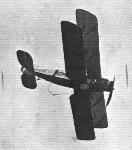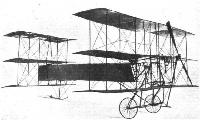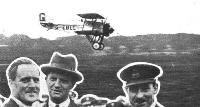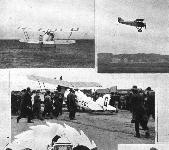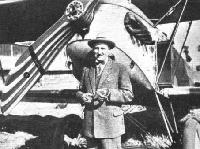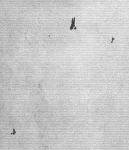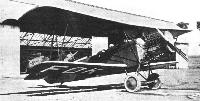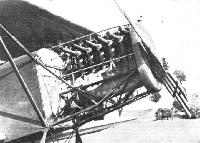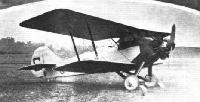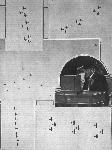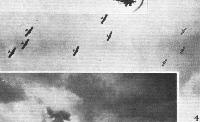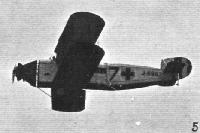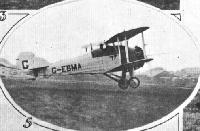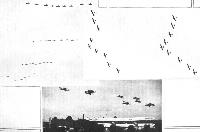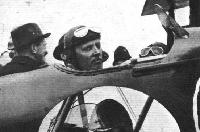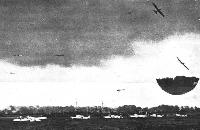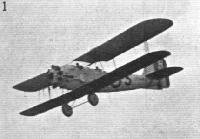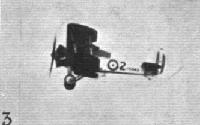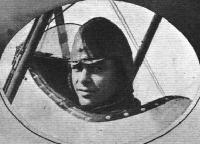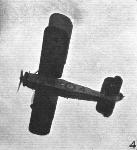Фотографии
-
WITH THE MEDITERRANEAN FLEET AT GENOA: The two photographs were taken on the occasion of the visit of the Mediterranean Squadron of the British Fleet to Genoa, and they depict one of the Fairey seaplanes, attached to the Fleet, taking in a supply of "Shell" Aviation Spirit.
Самолёты на фотографии: Fairey Fairey III - Великобритания - 1917
-
FIGHTING TACTICS AT THE R.A.F. DISPLAY: In Event No.9 a demonstration of flight evolutions in aerial attack was given by three Siddeley ''Siskins'' (No. 41 Fighter Squadron), three Gloucestershire "Grebes" (No. 32 Fighter Squadron), and two Bristol Fighters (No.24 Communication Squadron), In the picture some of the "Siskins" and "Grebes" are seen opening the attack on one of the Bristol Fighters.
Самолёты на фотографии: Armstrong Whitworth Siskin - Великобритания - 1921Bristol F.2A/F.2B Fighter - Великобритания - 1916Gloster Grebe - Великобритания - 1923
-
Регистрационный номер: F4513 AT THE R.A.F. DISPLAY: Event No. 2, the Message Picking-up Competition. The Bristol "Fighter" F.4513 from No. 16 (Army Co-operation) Squadron dives to pick up its message, which is suspended in a bag on a line between two posts by means of the line, provided with hooks, seen trailing below the fuselage.
Самолёты на фотографии: Bristol F.2A/F.2B Fighter - Великобритания - 1916
-
AT THE R.A.F. DISPLAY: Event No. 1, the Landing Competition for a cup presented by the Duke of York. Above, six of the Avros from the various training schools lined up for the start. Inset No. 1, Flying Training School Avro landing in the "field."
Самолёты на фотографии: Avro Avro 504 - Великобритания - 1913
-
The original Avro Triplane, which has been presented to South Kensington Museum.
Самолёты на фотографии: Avro Triplane I - III - Великобритания - 1909
-
Регистрационный номер: G-EBLL THE KING'S CUP: The second man to finish, H. W. G. Jones, landing at Croydon on Saturday and receiving congratulations. He started in the race as a Flight-Lieutenant, R.A.P., and finished up as Squadron-Leader.
Самолёты на фотографии: Armstrong Whitworth Siskin - Великобритания - 1921
-
The Armstrong-Whitworth "Siskin" with 395 h.p. Armstrong Siddeley "Jaguar" engine is taking part in the King's Cup race in three examples, one of which is of the type IV and two of the type V. The two Siskin V's have been entered by Sir Eric Geddes and Major F. M. Green, and will be piloted by Capt. F. L. Barnard and Capt. J. L.N.B. Baggs, respectively. The Siskin IV has been entered by Sir Glynn H. West, and will be piloted by Flight-Lieut. H. W. G. Jones
Самолёты на фотографии: Armstrong Whitworth Siskin - Великобритания - 1921
-
Регистрационный номер: G-EBLQ THE STORY OF A FAMOUS VICTORY: Capt. F. L. Barnard (left) leaves Croydon on Friday, July 3, at 9.48 a.m., and (right) arrives safely back (for the second time) on Saturday, July 4, at 4 p.m., having thus completed two circuits of Britain, or 1,608 miles. As a result, he is "mobbed" by an enthusiastic crowd, led by Press photographers and wins the cup.
Самолёты на фотографии: Armstrong Whitworth Siskin - Великобритания - 1921
-
"AFTER YOU WITH THAT TANK!" One of the most thrilling events seen at this year's R.A.F. Display at Hendon was the demonstration of Low Bombing by three Gloucestershire "Grebes" from No. 25 Fighter Squadron, and three Siddeley "Siskins" from No.41 Fighter Squadron. Instead of the machines diving on to their target - a stranded Tank - one after another from the same direction, they maintained a continuous attack, swooping down in rapid succession from all directions, with, apparently, only a matter of yards separating each machine, and releasing their bombs from about 50 ft. without the use of bombsights or such-like gadgets. The picture by Charles Dickson, gives one an excellent impression of this wonderful "criss-crossing" manoeuvre by the machines.
Самолёты на фотографии: Armstrong Whitworth Siskin - Великобритания - 1921Gloster Grebe - Великобритания - 1923
-
Регистрационный номер: G-EBKT [2] Two De Havilland "Moths" with 65 h.p. "Cirrus" engines are taking part in the King's Cup race. One has been entered and will be piloted by Cap. G de Havilland, and the other has been entered by Sir Charles Wakefield and will be flown by Mr. Alan J. Cobham. The machine shown in our photograph is the one entered by Sir Charles Wakefield.
Самолёты на фотографии: De Havilland Moth / D.H.60 - Великобритания - 1925
-
Регистрационный номер: G-EBKT [2], G-EBKU THE KING'S CUP: The first away on Friday were two D.H.60 "Moths" - G-EBKT, piloted by A. J. Cobham, and G-EBKU, piloted by Capt. de Havilland - shown taking off.
Самолёты на фотографии: De Havilland Moth / D.H.60 - Великобритания - 1925
-
THE KING'S CUP CONSOLATION HANDICAP: 2, Alan J. Cobham, who finished second on Sir Charles Wakefield's D.H.60 Moth.
Самолёты на фотографии: De Havilland Moth / D.H.60 - Великобритания - 1925
-
A batch of Fokker machines with Napier "Lion" engines in the Fokker factory at Amsterdam.
Самолёты на фотографии: Fokker C.IV / DC.I - Нидерланды - 1923
-
Mr. B. Stephan, general manager of the Fokker works, standing by a Fokker biplane with Napier "Lion" engine.
Самолёты на фотографии: Fokker C.IV / DC.I - Нидерланды - 1923
-
FIGHTING TACTICS AT THE R.A.F. DISPLAY: Event No. 6, an aerial combat between a Boulton and Paul "Bugle" twin-engined bomber, piloted by Sqdn.-Ldr. W. H. Longton, D.F.C., A.F.C., and two Gloucestershire "Grebe" single-seater fighters, piloted respectively by Flight-Lieut. H. A. Hammersley, M.C., and Flying Officer J. N. Boothman. In this display the bomber (in centre) put up an excellent defence.
Самолёты на фотографии: Boulton Paul P.15 Bolton / P.25 Bugle - Великобритания - 1922Gloster Grebe - Великобритания - 1923
-
Регистрационный номер: J7266 THE BOULTON AND PAUL "BUGLE": This photograph shows the latest type of "Bugle" which is fitted with Napier "Lion" engines. In general the machine is similar to that described in FLIGHT some months ago with the exception of the change in the engines and their mounting. It may also be noticed that the petrol tanks have now disappeared from the top 'plane. They are now carried inside the fuselage. A further modification is that the elevators are balanced by horn balances. As the machine has been built by the Air Ministry no details as to performance may be given. The performances, however, are extremely good, as is also the manoeuvrability.
Самолёты на фотографии: Boulton Paul P.15 Bolton / P.25 Bugle - Великобритания - 1922
-
The Fokker C.VI, with B.M.W. engine and nose radiator.
Самолёты на фотографии: Fokker C.V / C.VI - Нидерланды - 1924
-
The latest type of B.M.W. engine in the Fokker C.VI.
Самолёты на фотографии: Fokker C.V / C.VI - Нидерланды - 1924
-
The Armstrong-Whitworth "Ajax," entered by Mr. J.D. Siddeley, is a two-seater biplane fitted with 395 h.p.Siddeley "Jaguar" engine. In the competition this machine will be piloted by Mr. Frank Courtney.
Самолёты на фотографии: Armstrong Whitworth Atlas / Ajax - Великобритания - 1925
-
Dr. Lhota standing by the Walter engine of his B.H.9 monoplane, on which he flew from Prague to Rome and back.
Самолёты на фотографии: Avia BH-9 / BH-10 / BH-11 / BH-12 / BH-16 - Чехословакия - 1923
-
Регистрационный номер: L-BONF PRAGUE - ROME - PRAGUE: Dr. Lhota, the well-known Czech pilot, recently flew from Prague to Rome and back in this Avia B.H.9 fitted with 60 h.p. Walter engine.
Самолёты на фотографии: Avia BH-9 / BH-10 / BH-11 / BH-12 / BH-16 - Чехословакия - 1923
-
THE GRANDE FINALE AT THE R.A.F. DISPLAY: (3) Three Avro "Aldershot" heavy bombers
Самолёты на фотографии: Avro Aldershot / Type 549 - Великобритания - 1922
-
"HALLO, MOSQUITOS! ALTER COURSE 16 POINTS OUTWARDS." - This was the command given by the King to No.25 Fighter Squadron, under Squadron-Leader A. H. Peck, by means of wireless during the squadron drill at the R.A.F. Display. We show above his Majesty speaking into the microphone, and also some of the formations carried out by the nine "Grebes." (1) "Flight Mass Line Abreast." (2) "Flight Mass Echelon to Port." (3) "Double Line Ahead" (immediately preceding the King's order). (4) "Line Abreast." (5) "Flight Mass Line Ahead."
Самолёты на фотографии: Gloster Grebe - Великобритания - 1923
-
THE GRANDE FINALE AT THE R.A.F. DISPLAY: (4) Nine Vickers "Virginia" dittoes arrive from a base thoughtfully provided near by, loaded with a few best-quality pills
Самолёты на фотографии: Vickers Virginia - Великобритания - 1922
-
Регистрационный номер: J6997 "NEW AND EXPERIMENTAL": Some of the machines which took part in the "Fly Past" at the R.A.F. Display. (5) Bristol "Brandon" (400 h.p. Bristol "Jupiter"), an ambulance 'plane.
Самолёты на фотографии: Bristol Ten-Seater / Brandon - Великобритания - 1921
-
Регистрационный номер: G-EBIH ADVANCED TRAINING MACHINE: This Bristol biplane with Bristol Jupiter engine is used at the Bristol Flying School for the advanced training of pupils, and as such is, perhaps, the highest-powered training machine in regular use. For school purposes, however, the speed of the Jupiter is cut down to a certain figure, so that the actual power normally developed when used in a school machine is not the full power of the engine.
Самолёты на фотографии: Bristol Jupiter-Fighter / Advanced Trainer - Великобритания - 1923
-
ONE OF THREE BRISTOL MACHINES ENTERED FOR THE LYMPNE MEETING: The "Bloodhound," with 400 h.p. Bristol "Jupiter" engine.
Самолёты на фотографии: Bristol Bloodhound / Type 84 - Великобритания - 1923
-
Регистрационный номер: G-EBGG [2] The Bristol "Bloodhound," entered by Sir G. Stanley White, is an all-metal biplane with 400 h.p. Bristol "Jupiter" engine. It will be piloted by Mr. T. W. Campbell.
Самолёты на фотографии: Bristol Bloodhound / Type 84 - Великобритания - 1923
-
Регистрационный номер: G-EBGG [2] THE KING'S CUP: Some of the first day's starters. 4, T. W. Campbell well away on the Bristol "Bloodhound."
Самолёты на фотографии: Bristol Bloodhound / Type 84 - Великобритания - 1923
-
The Hawker "Woodcock" with 400 h.p. Bristol "Jupiter" engine, entered by Mr. T. O. M. Sopwith, will be piloted by Flight-Lieut. P. W. S. Bulman.
Самолёты на фотографии: Hawker Woodcock - Великобритания - 1923
-
Регистрационный номер: G-EBMA THE KING'S CUP: Some of the first day's starters. 5, Bulman on the Hawker Woodcock, dodging the rain.
Самолёты на фотографии: Hawker Woodcock - Великобритания - 1923
-
THE GRANDE FINALE AT THE R.A.F. DISPLAY: (2) Five Fairey "Flycatcher" Fleet Fighters arrive to the support of the "Seagull."
Самолёты на фотографии: Fairey Flycatcher - Великобритания - 1922
-
Wing Evolutions by four Bombing Squadrons (18 Fairey "Fawns," and 18 D.H.9a's). On the left the machines changing from "Wing Line Ahead Squadrons Line Abreast" to " Wing in Line Ahead of Squadrons." On the right two Squadrons changing from "Squadron" to "Squadron Mass."
Самолёты на фотографии: Fairey Pintail / Fawn - Великобритания - 1920
-
SOME LIGHT PLANES COMPETING AT LYMPNE: The Hawker "Cygnet" with British Anzani engine.
Самолёты на фотографии: Hawker Cygnet - Великобритания - 1924
-
Регистрационный номер: G-EBDO THE KING'S CUP: The third and last competitor to finish was Maj. H. Hemming, who flew Mr. A. S. Butler's D.H.37 "Sylvia" (275 h.p. Rolls-Royce "Falcon"), which is shown on the right taking-off from Croydon on Friday.
Самолёты на фотографии: De Havilland D.H.37 - Великобритания - 1922
-
Регистрационный номер: G-EBIM [3] The D.H. 51a, with 120 h.p. Airdisco engine has been entered by "Steve'' Donoghue, and will be piloted by Capt. C. D. Barnard. This machine differs from that entered by Air-Commodore Weir in having one pair of inter-plane struts only.
Самолёты на фотографии: De Havilland D.H.51 - Великобритания - 1924
-
THE KING'S CUP: Donoghue's D.H.51A, "Come on, Steve," piloted by C. D. Barnard, and the "Airdisco" Avro (W. H. Perry), waiting for their signal to start.
Самолёты на фотографии: Avro Type 548 - Великобритания - 1919De Havilland D.H.51 - Великобритания - 1924
-
Регистрационный номер: G-EBIM [3] THE KING'S CUP: Some of the first day's starters. 2, Donoghue's D.H.51a, C. D. Barnard up.
Самолёты на фотографии: De Havilland D.H.51 - Великобритания - 1924
-
Регистрационный номер: G-EBIM [3] The D.H.51a with 120 h.p. Airdisco engine has been entered by Air-Commodore J. G. Weir, and will be piloted by Colonel the Master of Sempill
Самолёты на фотографии: De Havilland D.H.51 - Великобритания - 1924
-
THE KING'S CUP CONSOLATION HANDICAP: 1, Colonel the Master of Sempill, who won Friday's miniature King's Cup Race on the D.H.51 entered by Air-Comm. J. G. Weir.
Самолёты на фотографии: De Havilland D.H.51 - Великобритания - 1924
-
THE LIGHTER SIDE OF THE R.A.F. DISPLAY: Event No. 3, the Light Aeroplane Race, open to the Directorates of the Air Ministry, on D.H. 53's. Above, four of the six D.H. 53's entered finishing their first lap (about 5 miles). Below, the line up of the six youngsters before the start. Inset, the winning machine (Wing-Comdr. W. S. Douglas, M.C., D.F.C., "Equipment") finishing.
Самолёты на фотографии: De Havilland Humming Bird / D.H.53 - Великобритания - 1923
-
Регистрационный номер: N148 A NEW ENGLISH ELECTRIC COMPANY FLYING BOAT: The Ayr Napier-engined Flying Boat is remarkable for the fact that it has no wing tip floats, the bottom plane doing all, and performing the functions of side floats, the inner portion of it being submerged when the machine is at rest on the water. This machine, like all other of English Electric Company construction was designed by Mr. W. O. Manning. The engine is a 450 h.p. Napier "Lion."
Самолёты на фотографии: English Electric Ayr - Великобритания - 1924
-
Регистрационный номер: G-EBJK ONE OF THREE BRISTOL MACHINES ENTERED FOR THE LYMPNE MEETING: The Bristol "Brownie" light monoplane with Bristol "Cherub" engine.
Самолёты на фотографии: Bristol Brownie / Type 91 - Великобритания - 1924
-
"NEW AND EXPERIMENTAL": Some of the machines which took part in the "Fly Past" at the R.A.F. Display. (1) Short "Springbok" (400 h.p. Bristol "Jupiter"), an all-metal Army Co-operation biplane.
Самолёты на фотографии: Short Springbok / Chamois / S.3 - Великобритания - 1923
-
MR. HAROLD VANDERBILT'S NEW AIR YACHT: The new monoplane flying boat, fitted with a 450 h.p. Napier "Lion," that has just been completed at Long Island, N.Y., to the order of Mr. Harold Vanderbilt, and to which reference has previously been made in "Flight." It is a five-seater of metal construction - corrugated duralumin being largely employed - and has been designed and built by the Kirkham Products Corporation, Garden City, N.Y. Span, 47 ft; speed range, 60-145 m.p.h.; weight empty, 3,700 lb.; range of action, 4 1/2 hours
Самолёты на фотографии: Kirkham Air Yacht - США - 1925
-
Регистрационный номер: J6989 "NEW AND EXPERIMENTAL": Some of the machines which took part in the "Fly Past" at the R.A.F. Display. (3) Hawker "Heron" (400 h.p. Bristol "Jupiter"), a single-seater fighter mainly of metal construction.
Самолёты на фотографии: Hawker Heron / Hornbill / Hawfinch / Hoopoe - Великобритания - 1925
-
Регистрационный номер: G-EBKN THE KING'S CUP: Some of the first day's starters. 1, Perry, off on the "Airdisco" Avro, 120 h.p. Airdisco engine.
Самолёты на фотографии: Avro Type 548 - Великобритания - 1919
-
The Airdisco-Avro is a standard Avro biplane, but fitted with 120 h.p. Airdisco engine. The machine has been entered by Colonel Barrett Lennard, and will be piloted by Mr. H. H. Perry
Самолёты на фотографии: Avro Type 548 - Великобритания - 1919
-
THE SAVOIA S.58: Three-quarter front view of the single-seater fighter flying boat, fitted with 300 h.p. Hispano-Suiza.
Самолёты на фотографии: Savoia-Marchetti / SIAI S.57 / S.58 / S.59 - Италия - 1923
-
THE SAVOIA S.58: Side view of the single-seater fighter flying boat.
Самолёты на фотографии: Savoia-Marchetti / SIAI S.57 / S.58 / S.59 - Италия - 1923
-
Savoia S.58 300 hp Hispano-Suiza Engine
Самолёты на фотографии: Savoia-Marchetti / SIAI S.57 / S.58 / S.59 - Италия - 1923
-
THE SAVOIA S.52 Three-quarter front view of a land type fighter constructed by the Italian S.I.A.I. It has a 300 h.p. Hispano-Suiza.
Самолёты на фотографии: Marchetti-Vickers-Terni MVT - Италия - 1919
-
THE SAVOIA S.52: Side view of the Savoia land 'plane, showing the "clean" lines of its design.
Самолёты на фотографии: Marchetti-Vickers-Terni MVT - Италия - 1919
-
Savoia S.52 300 hp Hispano-Suiza Engine
Самолёты на фотографии: Marchetti-Vickers-Terni MVT - Италия - 1919
-
"LARGE" AEROPLANES TAKING PART IN THE LYMPNE MEETING: The Sopwith "Gnu" with 110 h.p. le Rhone
Самолёты на фотографии: Sopwith Gnu - Великобритания - 1919
-
AVROS FOR GREECE: Our photograph shows four of a batch of "Avro-Lynx" biplanes built for Greece. With its Oleo undercarriage and reliable Siddeley "Lynx" engine, the Avro 504N, is a remarkably successful training machine. Standing in front of the second machine from the right are representatives of the Greek Government.
Самолёты на фотографии: Avro Avro 504N - Великобритания - 1920
-
THE KING'S CUP CONSOLATION HANDICAP: 3, Bert Hinkler, who obtained third place on A. V. Roe's Avro 504N.
Самолёты на фотографии: Avro Avro 504N - Великобритания - 1920
-
Регистрационный номер: G-EBKQ THE KING'S CUP: Some of the first day's starters. 3, Bert Hinkler gets away on the Avro 504N.
Самолёты на фотографии: Avro Avro 504N - Великобритания - 1920
-
Регистрационный номер: G-EBKP SOME LIGHT PLANES COMPETING AT LYMPNE: The Avro "Avis" with Bristol "Cherub."
Самолёты на фотографии: Avro Avis / Type 562 - Великобритания - 1924
-
Регистрационный номер: H-NACO SOME LIGHT PLANES COMPETING AT LYMPNE: The Pander monoplane with 30 h.p. French Anzani.
Самолёты на фотографии: Holland (VIH) H.2 - Нидерланды - 1924
-
Регистрационный номер: G-EBKL THE KING'S CUP: Some of the first day's starters. W.H. Longton's A.D.C. Martinsyde hurrying to the line.
Самолёты на фотографии: Martinsyde A.D.C.1 / Nimbus - Великобритания - 1924
-
Регистрационный номер: N187 "NEW AND EXPERIMENTAL": Some of the machines which took part in the "Fly Past" at the R.A.F. Display. (4) Hawker "Hedgehog" (400 h.p. Bristol "Jupiter"), a three-seater reconnaissance machine.
Самолёты на фотографии: Hawker Hedgehog - Великобритания - 1924
-
Регистрационный номер: G-EBMC [2] Cranwell C.L.A.3: Three-quarter front view. Note the careful streamlining of the nose.
Самолёты на фотографии: Comper Cranwell III / CLA.3 - Великобритания - 1925
-
Регистрационный номер: G-EBMC [2] THE CRANWELL C.L.A.3 MONOPLANE: View of the fuselage, showing construction, undercarriage, engine mounting, etc.
Самолёты на фотографии: Comper Cranwell III / CLA.3 - Великобритания - 1925
-
SOME CONSTRUCTIONAL DETAILS OF THE CRANWELL C.L.A.3 LIGHT MONOPLANE: 1. Attachment of lift strut to front wing spar. A wood block filler between fitting and bottom of spar has been omitted so as to show the bolt. 2. The rear spar strut fitting has a bolt passing vertically through the spar. 3. The controls incorporate a universal joint of somewhat unusual design, necessitated by the fact that the pilot sits on the floor of the cockpit. 4. Shows the construction of a rib, while 5 is a typical fuselage joint. The joints in the top and bottom bays are staggered in relation to those in the side bays so as to allow the three-ply gussets to clear one another.
Самолёты на фотографии: Comper Cranwell III / CLA.3 - Великобритания - 1925
-
Launching by Catapult; One of the U.S. Navy Vought UO-1 Spotting Seaplanes being launched by means of a catapult from the deck of a warship during the Pacific Manoeuvres.
Самолёты на фотографии: Vought UO/FU - США - 1922
-
AT THE CROYDON MEETING ON EASTER MONDAY: The machines lined up for the Club Handicap. The first is B.E.2E, with 90 h.p. R.A.F.4.
Самолёты на фотографии: RAF B.E.2e - Великобритания - 1916
Статьи
- Flight


